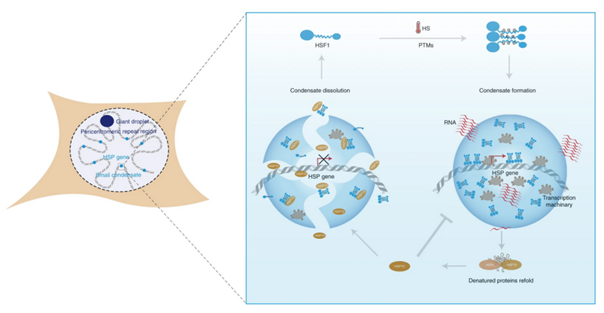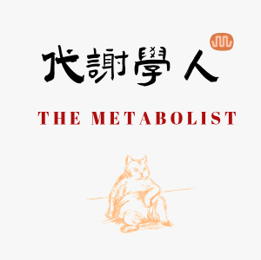博文
代谢学人--Nature子刊近期代谢精选
||
代谢学人
Nature子刊近期代谢精选
撰文 | 郑宇含 王佳雯 张彦康 李雨
编辑 | 孟美瑶
校对 | 张婷

九米鸭
为什么修勾能这么可爱?


难道是因为吃可爱多长大的?

同样令人疑惑的是
为什么肿瘤状态下骨骼肌异常代谢?
Nature Cell Biology发表研究揭示了
肿瘤来源的细胞外囊泡
通过miRNA抑制O-GlcNAc转移酶蛋白修饰
调控恶病质过程中骨骼肌蛋白水解
Nature Cell Biology
1、癌细胞分泌的miR-122抑制蛋白O-GlcNAc修饰以促进骨骼肌蛋白水解
肌肉在流失?都是miR-122惹的祸!
中文摘要
骨骼肌质量减少和肌肉力量下降是晚期癌症病人的预后因素。本文中,研究人员发现乳腺癌细胞分泌包裹miR-122的细胞外囊泡,可靶向OGT(O-GlcNAc转移酶),进而抑制肌肉中蛋白的O-GlcNAc(O-连接的N-乙酰葡糖胺)糖基化修饰。机制上,RYR1蛋白(兰尼碱受体1)的O-GlcNAc糖基化修饰与NEK10介导的磷酸化修饰存在竞争关系,并且,O-GlcNAc糖基化修饰可促进RYR1蛋白K48位点发生泛素化修饰并被蛋白酶体降解;而miR-122可靶向抑制OGT从而增加RYR1蛋白丰度。研究人员进一步发现,缺氧和乳酸通过HIF1A激活OGT启动子,从而调控肌肉蛋白的O-GlcNAc糖基化修饰,并且运动后肌肉蛋白O-GlcNAc糖基化修饰水平升高。在癌症背景下,抑制蛋白O-GlcNAc糖基化修饰会通过增加RYR1蛋白表达,引起肌肉细胞的细胞质中Ca2+浓度升高,激活钙蛋白酶,导致结蛋白丝断裂及肌原纤维破坏。这与荷瘤小鼠骨骼肌质量和收缩能力的下降现象一致。总之,本文发现肌肉蛋白的O-GlcNAc糖基化修饰与蛋白稳态和肌肉收缩性密切相关,并进一步揭示了癌症引起肌肉功能紊乱的分子机制。
拓展阅读:癌症与肌肉萎缩
与癌症有关的恶病质通常会引起肌肉萎缩,并伴随着肌肉相关蛋白的降解增加与合成减少,以及肌细胞凋亡增加和肌肉再生能力受损等现象。有研究发现肿瘤微环境产生的炎性因子如TNFα、IL-1β可直接激活肌肉细胞中NF-κB途径和p38 MAPK途径,促进E3连接酶MURF1和肌萎缩相关蛋白MAFBX的表达,从而促进肌肉蛋白的降解。除了肌肉相关蛋白的降解机制,肌源性细胞再生能力受损也是癌症诱导肌肉萎缩的重要因素,有研究发现在恶病质期间,NF-κB途径在肌肉细胞祖细胞中异常激活,导致PAX7蛋白(与肌肉再生相关蛋白)持续表达,PAX7的高表达抑制了肌源性细胞的分化,从而损害肌肉再生能力,并引起肌肉萎缩。 本篇文章中研究人员发现乳腺癌通过分泌包含miR-122的外泌体促使肌肉萎缩,具体而言,miR-122可靶向抑制肌细胞中OGT活性,抑制RYR1蛋白O-GlcNAc修饰,进而抑制RYR1泛素-蛋白酶体途径依赖的降解,导致RYR1水平升高,激活细胞内钙蛋白酶,从而促进肌肉相关蛋白稳态失调并引起肌萎缩。
参考文献:
[1] Argilés JM, etal. Nat Rev Cancer. 2014.
[2] Wei A He, etal. JClin Invest. 2013
Cancer-cell-secreted miR-122 suppresses O-GlcNAcylation to promote skeletal muscle proteolysis
一作:Wei Yan,PI:Shizhen Emily Wang
发表单位:Department of Pathology, University of California, San Diego, La Jolla, CA, USA
Abstract
A decline in skeletal muscle mass and low muscular strength are prognostic factors in advanced human cancers. Here we found that breast cancer suppressed O-linked N-acetylglucosamine (O-GlcNAc) protein modification in muscle through extracellular-vesicle-encapsulated miR-122, which targets O-GlcNAc transferase (OGT). Mechanistically, O-GlcNAcylation of ryanodine receptor 1 (RYR1) competed with NEK10-mediated phosphorylation and increased K48-linked ubiquitination and proteasomal degradation; the miR-122-mediated decrease in OGT resulted in increased RYR1 abundance. We further found that muscular protein O-GlcNAcylation was regulated by hypoxia and lactate through HIF1A-dependent OGT promoter activation and was elevated after exercise. Suppressed O-GlcNAcylation in the setting of cancer, through increasing RYR1, led to higher cytosolicCa2+ and calpain protease activation, which triggered cleavage of desmin filaments and myofibrillar destruction. This was associated with reduced skeletal muscle mass and contractility in tumour-bearing mice. Our findings link O-GlcNAcylation to muscular protein homoeostasis and contractility and reveal a mechanism of cancer-associated muscle dysregulation.
原文链接:https://www.nature.com/articles/s41556-022-00893-0
每天都想和猫主子说
“你已经是只成熟的猫了,该学会。。。”

自己开车

自己做研究
也有很多成熟的功能蛋白
在我们身体里各司其职维持稳态
面对高温时
成熟的热休克转录因子(HSF1)
能促进热休克蛋白(HSPs)的快速表达
Nature Cell Biology近期研究建立了
一个精细调节HSF1相分离的模型
揭示热休克条件下转录激活的分子机制
Nature Cell Biology
2、热休克过程中HSF1可逆相分离是急性转录应答反应所必需的
热休克应答新发现——HSF1可逆相分离
中文摘要
热休克转录因子1 (HSF1) 通过促进热休克蛋白(HSP)的表达快速且广泛地启动细胞热休克反应。然而HSF1如何快速且可逆地调控转录重编程仍不清楚。本文中,研究人员利用超分辨率成像、体内重建和高通量测序技术揭示了HSF1在HSP基因位点通过液-液相分离形成核内小凝聚体,并通过共相分离招募多个转录复合物促进靶基转录。此外,HSF1调控结构域中特定位点的磷酸化修饰可调节HSF1的相分离能力。最后,研究人员发现热休克反应结束后HSP70通过破坏HSF1凝聚体减弱转录,停止热休克反应,此外,Hsp70也可以阻止HSF1在延长的热休克过程中发生的凝胶样相变。总之,这些结果说明在急性应激过程中,存在一种可诱导和可逆的相分离反馈机制动态调控HSF1活性,促进基因转录从而维持蛋白质稳态。

拓展阅读:相分离
“相”是物质形态的科学说法,气态、液态和固态是三种常见的“相”,相分离过程即从单一的均相混合物中分离产生两种不同的相。在生物学领域中,相分离通常指生物大分子如蛋白质、核酸等形成凝聚体的特殊状态,具有不同于可溶大分子的物理性质和生物功能。有研究发现在细胞衰老的过程中,ALS(肌萎缩侧索硬化症,一种神经退行性疾病)相关蛋白FUS会发生相分离形成异常聚集状态,促进ALS的发生发展;也有研究发现不同的转录因子如OCT4、GCN4可通过其转录激活域发生相分离形成凝聚体,激活基因的转录表达。
本篇文章发现在应激条件下,HSF1在细胞核内HSP基因附近形成凝聚体,并招募多个转录复合物,促进HSP基因的转录表达,快速启动细胞热休克反应。而在热休克反应结束时HSP70蛋白可反过来破坏HSF1凝聚体,从而抑制HSF1的转录活性。
参考文献:
[1] Steven Boeynaems, et al. Trends CellBiol. 2018
[2] Ann Boija, et al. Cell. 2018 [3] Avinash Patel, etal. Cell. 2015
Reversible phase separation of HSF1 is required for an acute transcriptional response during heat shock
一作:Hongchen Zhang,PI:Shipeng Shao
发表单位:State Key Laboratory of Membrane Biology, Biomedical Pioneering Innovation Center (BIOPIC), School of Life Sciences, Peking University, Beijing, China
Abstract
Heat-shock transcription factor 1 (HSF1) orchestrates the fast and vast cellular response to heat shock through increased expression of heat-shock proteins. However, how HSF1 rapidly and reversibly regulates transcriptional reprogramming remains poorly defined. Here by combining super-resolution imaging, in vitro reconstitution and high-throughput sequencing, we reveal that HSF1 forms small nuclear condensates via liquid–liquid phase separation at heat-shock-protein gene loci and enriches multiple transcription apparatuses through co-phase separation to promote the transcription of target genes. Furthermore, the phase-separation capability of HSF1 is fine-tuned through phosphorylation at specific sites within the regulatory domain. Last, we discovered that HSP70 disperses HSF1 condensates to attenuate transcription following the cessation of heat shock and further prevents the gel-like phase transition of HSF1 under extended heat-shock stress. Our work reveals an inducible and reversible phase-separation feedback mechanism for dynamic regulation of HSF1 activity to drive the transcriptional response and maintain protein homeostasis during acute stress.
原文链接:https://www.nature.com/articles/s41556-022-00846-7
刚开始养猫猫只是为了陪伴
不知不觉间却开发出各种神奇功能



最开始的FOXM1被发现在胰腺癌、乳腺癌等
肿瘤发生发展中起促进作用
但后面研究又开发出FOXM1的其他功能
Nature Aging最新研究发现
FOXM1的非转录功能
可以延缓衰老相关的早衰症和自然衰老
Nature Aging
1、体内周期性诱导FOXM1转录因子表达可延缓自然衰老和早衰表型并延长寿命
延缓衰老的“硬核”分子——FOXM1
中文摘要
转录因子FOXM1在维持细胞稳态的多种生物学过程中具有C端转录和N端非转录功能,表现出功能多效性。先前研究发现在细胞衰老过程中,FOXM1受到抑制导致细胞出现衰老表型,而过表达转录激活形式的FOXM1可延缓细胞衰老。然而,增加FOXM1表达是否可以延缓机体的衰老尚不清楚。本文中,研究人员发现在早衰小鼠和自然衰老小鼠体内以周期性方式诱导N端截短形式的FOXM1(转录激活形式的FOXM1)表达可抵消衰老对全长内源性Foxm1的抑制效应,恢复其转录和非转录功能,减少部分细胞衰老标志表达,并在Hutchison–Gilford短寿早衰小鼠中改善分子和组织病理学特征,延长小鼠寿命。此外,在自然衰老小鼠诱导FOXM1表达也恢复了内源的FOXM1水平,并缓解小鼠衰老表型延长寿命。因此,这些结果揭示了FOXM1基因重组可缓解早衰和自然衰老相关病理。
拓展阅读:FOXM1与衰老
FOXM1是Forkhead家族的转录因子,是有丝分裂的重要调控因子,主要驱动G2/M期基因的表达。有研究发现FOXM1是衰老细胞有丝分裂异常的分子决定因素,在细胞衰老过程中,FOXM1表达下调,使细胞周期基因表达失调,导致细胞出现染色体非整倍数现象,最终引发细胞周期永久停滞和细胞完全衰老现象。而过表达FOXM1可防止细胞出现染色体非整倍数化并延缓衰老。本篇文章发现FOXM1不仅可以延缓细胞衰老,同样也可以改善机体的衰老表型。研究人员在自然衰老小鼠和早衰小鼠体内过表达转录激活形式的FOXM1,发现外源FOXM1的过表达恢复了内源FOXM1的活性,进而缓解小鼠衰老表现并延长寿命。
参考文献:
[1] Jamila Laoukili,Mol CellBiol, 2008
[2] Joana Catarina Macedo, Nat Commun. 2018
In vivo cyclic induction of the FOXM1 transcription factor delays natural and progeroid aging phenotypes and extends healthspan
一作:Rui Ribeiro,PI:Elsa Logarinho
发表单位:Aging and Aneuploidy Laboratory, i3S – Instituto de Investigação e Inovação em Saúde, IBMC - Instituto de Biologia Molecular e Celular, Universidade do Porto, Porto, Portugal
Abstract
The FOXM1 transcription factor exhibits pleiotropic C-terminal transcriptional and N-terminal non-transcriptional functions in various biological processes critical for cellular homeostasis. We previously found that FOXM1 repression during cellular aging underlies the senescence phenotypes, which were vastly restored by overexpressing transcriptionally active FOXM1. Yet, it remains unknown whether increased expression of FOXM1 can delay organismal aging. Here, we show that in vivo cyclic induction of an N-terminal truncated FOXM1 transgene on progeroid and naturally aged mice offsets aging-associated repression of full-length endogenous Foxm1, reinstating both transcriptional and non-transcriptional functions. This translated into mitigation of several cellular aging hallmarks, as well as molecular and histopathological progeroid features of the short-lived Hutchison–Gilford progeria mouse model, significantly extending its lifespan. FOXM1 transgene induction also reinstated endogenous Foxm1 levels in naturally aged mice, delaying aging phenotypes while extending their lifespan. Thus, we disclose that FOXM1 genetic rewiring can delay senescence-associated progeroid and natural aging pathologies.
原文链接:https://www.nature.com/articles/s43587-022-00209-9
关注微信公众号代谢学人
了解更多代谢前沿资讯

https://blog.sciencenet.cn/blog-3483272-1340279.html
上一篇:代谢学人--Nature Metabolism:治疗糖尿病,从对抗β细胞衰老开始!
下一篇:代谢学人--Science子刊:STM近期代谢精选